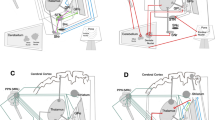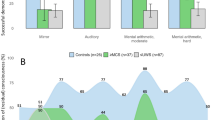Summary
Head movement-dependent oscillopsia (HMDO) with peripheral vestibular, brainstem and cerebellar lesions is reviewed. The differentiation of this kind of oscillopsia is based mainly on clinical grounds. HMDO with bilateral abolition of caloric responses, and in the absence of disease of the central nervous system, is due to bilateral vestibular disease. HMDO in patients with internuclear ophthalmoplegia and other brainstem signs is probably due to a lesion of VOR pathways in or near the medial longitudinal fasciculus. The occurrence of HMDO with ataxia of gait and cerebellar eye movement disorders (rebound nystagmus, flutter-like oscillations), in the absence of brainstem lesions (medial longitudinal fasciculus), is clinical evidence for HMDO due to a cerebellar lesion. An attempt is made to associate the different kinds of oscillopsia with current knowledge of the vestibulo-ocular reflexes.
Zusammenfassung
Unter kopfbewegungsabhängiger Oszillopsie versteht man Scheinbewegungen der Umwelt während Kopfbewegungen. Ursache ist eine Funktionsstörung der vestibulo-okulären Reflexe. Dies hat eine mangelhafte Stabilisierung der Augen in Richtung auf das fixierte Objekt zur Folge, da bei rascheren Kopfbewegungen die visuellen Fixationsreflexe allein nicht ausreichen zur Blickstabilisierung. Patienten mit kopfbewegungsabhängiger Oszillopsie sind vor allem beim Gehen, aber auch beim Fahren auf holperigen Straßen stark behindert, da alles auf und ab oder hin und her tanzt, je nachdem der Kopf mehr vertikal oder mehr horizontal erschüttert wird.
Am häufigsten kommt es nach beidseitigem Labyrinth- oder Nervus-vestibularis-Ausfall zu kopfbewegungsabhängiger Oszillopsie (Streptomycin u.ä. ototoxische Medikamente, operative Eingriffe). Aber auch Erkrankungen im Bereich der vestibulo-okulären Verbindungen im Hirnstamm und im Kleinhirn (Vestibulo- oder Archicerebellum) führen zu kopfbewegungsabhängiger Oszillopsie. Zur Lokalisierung solcher Läsionen können zusätzliche blickmotorische Störungen bei Hirnstamm- (internukleäre Ophthalmoplegie) oder Kleinhirn- (Rebound-Nystagmus usw.) Erkrankungen beigezogen werden. Besonderheiten der kopfbewegungsabhängigen Oszillopsie bei zentralnervösen Störungen sowie deren theoretischen Implikationen werden besprochen.
Similar content being viewed by others
References
Atkin, A., Bender, M. B.: Ocular stabilization during oscillatory head movements. Arch. Neurol. 19, 559–566 (1968)
Baker, R., Berthoz, A.: Is the prepositus hypoglossi nucleus the source of another vestibular ocular pathway? Brain Res. 86, 121–127 (1975)
Baloh, R. W., Konrad, R. H., Honrubia, V.: Vestibulo-ocular function in patients with cerebellar atrophy. Neurology 25, 160–168 (1975)
Bender, M. B.: Oscillopsia. Arch. Neurol. 13, 204–213 (1965)
Bender, M. B., Feldman, M.: Visual illusions during head movement in lesions of the brainstem. Arch. Neurol. 17, 354–364 (1967)
Benson, A. J.: Interactions between semicircular canals and gravireceptors. In: Proceedings XVIII International Congress of Aviation and Space Medicine, Amsterdam 1969
Brickner, R. H.: Oscillopsia. Arch. Neurol. Psychiatr. 36, 586–589 (1936)
Brodal, A.: Neurological anatomy in relation to clinical medicine, p. 292. New York, London, Toronto: Oxford 1969
Brown, H. A., Hinshaw, H. C.: Toxic reaction of streptomycin on the eighth nerve apparatus. Proc. Staff Meet. Mayo Clinic 21, 347–352 (1946)
Cogan, D. G.: Ocular dysmetria; flutter-like oscillations of the eyes and opsoclonus. Arch. Ophthal. 51, 318–335 (1954)
Cogan, D. G.: Neurology of the ocular muscles. Springfield, Ill.: Thomas 1956
Cogan, D. G.: Down-beat nystagmus. Arch. Ophthal. 80, 757–768 (1968)
Cohen, B.: The vestibulo-ocular reflex arc. In: Handbook of sensory physiology, Vol. 6. The vestibular system, part 1, pp. 477–540. Berlin, Heidelberg, New York: Springer 1974
Dandy, W. E.: The surgical treatment of Ménière's disease. Surg. Gynaecol. Obstet. 72, 421–425 (1941)
Ellenberger, C., Keltner, J. L., Stroud, M. H.: Ocular dyskinesia in cerebellar disease. Brain 95, 685–692 (1972)
Ford, F. R., Walsh, J. B.: Clinical observations upon the importance of the vestibular reflexes in ocular movements. Bull. Johns Hopkins Hosp. 58, 80–88 (1936)
Fowler, E. P., Seligman, E.: Otic complications of the streptomycin therapy. A preliminary report. J.A.M.A. 133, 87–91 (1947)
Fulton, J. F.: Physiology of the nervous system. New York: Oxford 1949
Glorig, A., Fowler, E. P.: Tests for labyrinthic function following streptomycin therapy. Ann. Otol. 56, 379–394 (1947)
Gordon, R. M., Bender, M. B.: Visual phenomena in lesions of the median longitudinal fasciculus. Arch. Neurol. 15, 238–240 (1966)
Graf, K.: Die Schädigungen des Vestibularis und Cochlearis durch Streptomycin. Pract. Oto-rhino-laryng. 10, 527–533 (1948)
Gresty, M. A., Hess, K., Leech, J.: Disorders of the vestibulo-ocular reflex producing oscillopsia and mechanisms compensating for loss of labyrinthine function. Brain 100, 693–716 (1977)
Guild, S. R.: cited by Hawkins, J. E., Preston, R. E.: Vestibular ototoxicity. In: The vestibular system, R. F. Nauton, ed. New York, San Francisco, London: Academic Press 1975
Hood, J. D., Kayan, A., Leech, J.: Rebound nystagmus. Brain 96, 507–526 (1973)
Hoyt, W. F., Daroff, R. B.: Supranuclear disorders of ocular control systems in man. In: The control of eye movements, P. Bach-y-Rita, C. C. Collins, eds. New York, London: Academic Press 1971
Ito, M.: The vestibulo-cerebellar relationship: Vestibulo-ocular reflex arc and flocculus. In: The vestibular system, F. R. Naunton, ed. New York, San Francisco, London: Academic Press 1975
Jatho, K.: Über Vestibularis- und Cochlearisschädigung bei Streptomycinbehandlungen und deren Bedeutung für die Otologie. Arch. Ohr. Nas. Kehlkopfheilk. 157, 276–300 (1950)
Jatho, K.: Über die Bedeutung des Dandy'schen Symptoms bei einseitigem Verlust der Vestibularisfunktion. Arch. Ohr. Nas. Kehlkopfheilk. 172, 543–552 (1958)
Jatho, K.: Experimentelle Untersuchungen zum objektiven Nachweis des Dandy'schen Symptoms bei einseitigem und beiderseitigem Verlust der Vestibularisfunktion. Arch. Ohr. Nas. Kehlkopfheilk. 177, 230–254 (1961)
Jung, R., Kornhuber, H. H.: Results of electronystagmography in man: The value of optokinetic, vestibular and spontaneous nystagmus for neurologic diagnosis and research. In: The oculomotor system, M. B. Bender, ed. New York: Harper and Row 1964
Kornhuber, H. H.: Der periodisch alternierende Nystagmus (Nystagmus alternans) und die Enthemmung des vestibulären Systems. Arch. Ohr. Nas. Kehlkopfheilk. 174, 182–209 (1959)
Leech, J., Gresty, M., Hess, K., Rudge, P.: Gaze failure, drifting eye movements and centripetal nystagmus in cerebellar disease. Brit. J. Ophthal. 61, 774–781 (1977)
Levin, P. M.: The syndrome of vestibular failure in man. J. Nerv. Ment. Dis. 89, 335–342 (1939)
Meiry, J. L.: Vestibular and proprioceptive stabilization of eye movements. In: The control of eye movements, P. Bach-y-Rita, C. C. Collins, eds. New York, London: Academic Press 1971
Meyer zum Gottesberge, A.: Störungen der visuellen Wahrnehmung nach Vestibularisausfall. Arch. Ohr. Nas. Kehlkopfheilk. 162, 62–66 (1952)
Orzechowski, C.: De l'ataxie dysmétrique des yeux. J. Physiol. Neurol. 35, 1–18 (1927)
Robinson, D. A.: How the oculomotor system repairs itself. Investigative ophthalmology 14, 413–415 (1975)
Stark, L., Vossius, G., Young, L. R.: Predictive control of eye tracking movements. IRE transactions on human factors in electronics, 52–56, Sept. (1962)
Zee, D. S., Friendlich, A. R., Robinson, D. A.: The mechanism of downbeat nystagmus. Arch. Neurol. (Chic.) 30, 227–237 (1974)
Zee, D. S., Yee, R. D., Cogan, D. G., Robinson, D. A., King Engel, W.: Ocular motor abnormalities in hereditary cerebellar ataxia. Brain 99, 207–234 (1976)
Author information
Authors and Affiliations
Rights and permissions
About this article
Cite this article
Hess, K., Gresty, M. & Leech, J. Clinical and theoretical aspects of head movement dependent oscillopsia (HMDO). J. Neurol. 219, 151–157 (1978). https://doi.org/10.1007/BF00314530
Received:
Issue Date:
DOI: https://doi.org/10.1007/BF00314530




